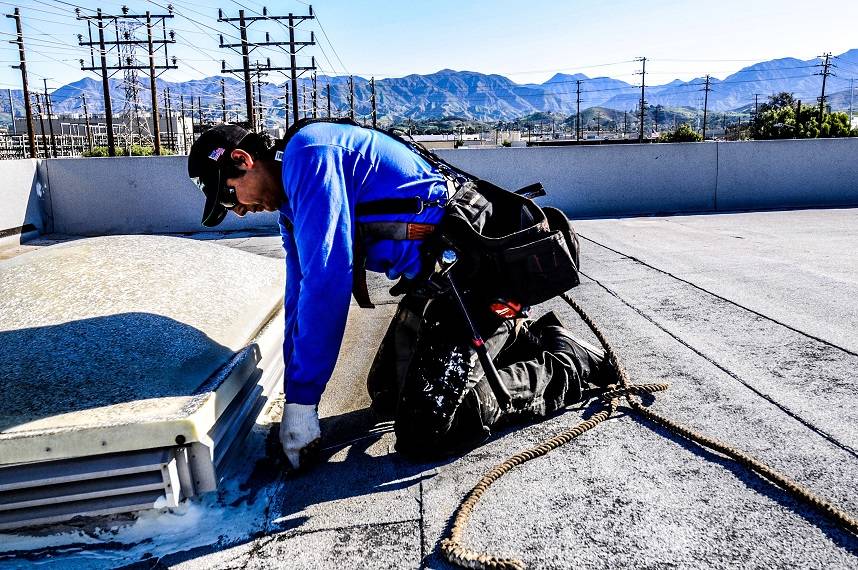Acrylic Roof Coatings Vs Silicone Roof Coatings, which commercial cool roof coating is better? It’s a common question that we get all the time. To answer that question we’re going to do a full comparison of the two types of roof coatings. Here’s what we’ll compare:
- Cost
- Longevity
- Reflectivity
- UV Stability
- Durability
- Resistance To Ponding Water
- Application & Clean Up
- Aesthetics
Introduction to Cool Roof Coatings
But First, let’s get a bit of background on the two cool roof coatings. Acrylic roof coatings have been around since The 1950s and remain a popular choice in the commercial roof restoration industry. They are suitable for use on a variety of roof systems including metal, modified bitumen, built-up roofs, EPDM, TPO, PVC, concrete, and spray polyurethane foam. Although acrylics are suitable for use on a variety of systems, they are highly recommended to only be used on steep-slope metal roofs where ponding water is not an issue. As a water-based material, acrylics do not hold up well to standing water.
Silicone coatings were introduced in the 60s. They were used primarily in spray foam roofing applications but eventually evolved into a suitable coating solution for a variety of other commercial roofing systems which include:
- Metal
- Modified bitumen
- Built-up roofs
- EPDM
- TPO
- PVC
- Concrete
Silicone Roof Coatings have taken over Acrylic as the most widely used coating material in modern commercial roof restoration. They are best known for their superior UV stability and resistance to ponding water. Silicones are a solvent-based material, meaning they are less susceptible to colder temperatures and therefore have a broader application window than water-based (acrylic) roof coatings.
Most of today’s silicone coating formulations have a solids content of 90% or greater, meaning that less liquid material is used during application to achieve the required dry film thickness.
Now that we’ve introduced both, let’s see how they do head to head.
COST
Since Acrylics are water-based and have been around longer in general they cost a bit less than Silicone Roof Coatings.
WINNER: Acrylic Roof Coatings
LONGEVITY
Silicone Coatings last longer than Acrylics, due to the fact that they reflect the Sun’s U.V rays better than Acrylic Coatings.
WINNER: Silicone Coatings
REFLECTIVITY
Silicone coated roofs tend to get dirty within 6-12 months after application which can lead to less reflectivity over time. However, periodic roof maintenance can reduce the dirt accumulation thus keeping the performance and reflectivity at optimal levels.
Whereas Acrylics don’t get dirty which give acrylics the edge when it comes to reflectivity.
WINNER: Silicone Coatings
UV STABILITY
Silicone Roofs additionally, do not chalk, break down or become brittle from prolonged exposure to the Sun’s UV rays.
WINNER: Silicone Coatings
DURABILITY
In terms of durability, they both are durable, however, in the long run (due to the U.V Stability, Reflectivity) silicones are more durable than acrylic roof coating systems.
WINNER: Silicone Coatings
RESISTANCE TO PONDING WATER
If you’re in a commercial building you’re more than likely to have a flat roof. Flat roofs are notorious for ponding water on the roof, especially after a heavy rainstorm. Silicone coatings prevent water from penetrating the surface allowing the water to pond on the roof and letting the Sun’s U.V rays dry up the sitting water.
Acrylics on the other hand tend to break down over time which decreases its resistance to ponding water.
WINNER: Silicone Coatings
APPLICATION & CLEAN UP
One advantage that acrylic coatings have over silicone is that they are much easier to install. This gives acrylic the advantage in the application and clean-up over silicone roof coatings.
WINNER: Acrylic Coatings
AESTHETICS
Lastly in our full comparison, when it comes to aesthetics, acrylic roof coatings are more aesthetically pleasing than silicones in the long run. Just as Silicone Roof Coatings are known for their resistance to ponding, they are just as known for the tendency to accumulate dirt.
The dirt adversely affects silicone’s longevity and performance and adding insult to injury makes them rather unsightly. Which makes roof maintenance key to the longevity and performance of silicone roof coatings.
Conversely Acrylic Roof Coatings don’t accumulate dirt, instead the dirt easily gets washed out by rain or wind keeping the aryclic roof coating almost prestine white.
WINNER Acrylic Coatings
Dirty Silicone Roof Coating
OVERALL WINNER: Silicone Roof Coatings
CONCLUSION
It’s important to note that pound-for-pound Silicone Roof Coatings are the best type of roof coating on the market today. But it doesn’t mean they are the most appropriate for every cool roof restoration project. Each project is different and there will be cases where an Acrylic Roof Coating System just makes more sense to install than silicone.
Lastly, I’d like to mention the environmental factors of both silicone and acrylic roof coatings. I didn’t do a head-to-head comparison because they are both relatively environmentally friendly. While acrylics are water-based which naturally makes them a safe choice for the environment, silicone coating technology has improved immensely in that they are formulated with little to no solvents and extremely low counts of volatile organic compounds. Making them both a pretty safe environmentally friendly option.
The bottom line is while silicone roof coatings are better overall, acrylics are no slouch either and they make a great roof coating option as well.
More a visual person? Check out this video on Arcylic and Silicone Roof Coatings.
